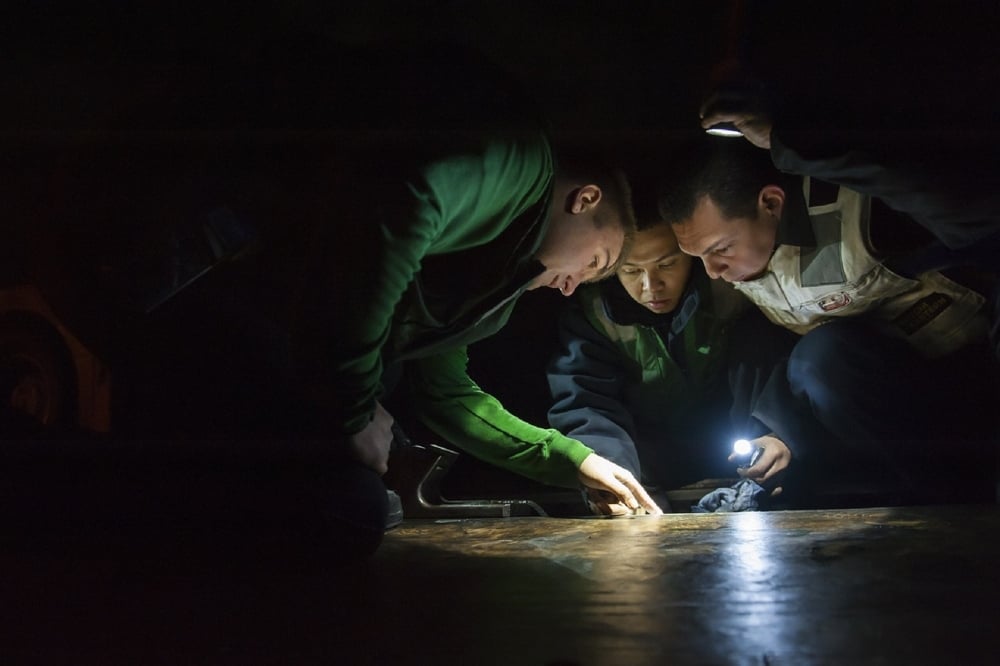NDT (NON-DESTRUCTIVE TESTING)
For instance, when inspectors in industrial settings review the outside of a pressure vessel with their naked eye, that would fall under the NDT designation, since they are collecting data on the status of the boiler without damaging it. On the other hand, using a sophisticated tool like an ultrasonic sensor to look for defects in a certain material or asset would also be called NDT.

Regardless of the specific use case, the underlying commonality among all these examples is the collection of data in a non-intrusive manner.
Here is a table of contents to help you navigate all the information related to NDT contained within this article:
- What Is NDT—A Closer Look
- The 8 Most Common NDT Methods
- Where Is Non-Destructive Testing Used?
- How Drones Can Help with NDT
What Is NDT—A Closer Look
We’ve already covered what NDT stands for and how the phrase is used in the field. Now let’s dive in and look more closely at some of the details that govern the world of NDT.
DESTRUCTIVE VS. NON-DESTRUCTIVE TESTING
Before we go any further, we should clarify that there are some methods used to test materials that alter—or even damage and destroy—the materials tested.
The use of these methods is called Destructive Testing.
In Destructive Testing, a piece of the material might be scraped away for analysis or altered in some way onsite.
Here are some examples:
- Macro sectioning. Macro sectioning tests a small section of a welded material by polishing and etching it for examination.
- Tensile testing. Also called tension testing, this is a destructive testing technique that uses controlled tension applied to a sample material to see how it reacts. Tension could be applied to test certain loads or conditions, or to test a material’s failure point.
- 3 point bend testing. 3 point bend testing examines the soundness and flexibility (or ductility) of a material by taking a sample of it, called a coupon, and bending it in three points to a specified angle.
Learn more about destructive testing methods here.
NDT CODES AND STANDARDS
NDT techniques can be used for all kinds of inspections. But some of the most important types of NDT inspections are of assets like boilers and pressure vessels, which could be incredibly dangerous if not properly maintained.
Because proper maintenance of these assets is so important for the safety of those working nearby (or even at a distance, when it comes to nuclear power plants), most countries have laws requiring companies to adhere to specific inspection codes and standards when conducting inspections.
These standards and codes typically require inspections to be conducted periodically following specific guidelines. For the most assets that present the greatest risk, these inspections must be both conducted by a certified inspector and approved by a certified witness working for a formal inspection body.
Here are the most commonly followed organizations in the world for creating NDT standards and codes:
- API (American Petroleum Institute)
- ASME (American Society for Mechanical Engineers)
- ASTM (American Society for Testing and Materials)
- ASNT (American Society For Nondestructive Testing)
- COFREND (French Committee for Non-destructive Testing Studies)
- CSA Group (Canadian Standards Association)
- CGSB (Canadian General Standards Board)
WHY USE NDT?
Here are the top reasons NDT is used by so many companies throughout the world:
- Savings. The most obvious answer to this question is that NDT is more appealing than destructive testing because it allows the material or object being examined to survive the examination unharmed, thus saving money and resources.
- Safety. NDT is also appealing because almost all NDT techniques (except radiographic testing) are harmless to people.
- Efficiency. NDT methods allow for the thorough and relatively quick evaluation of assets, which can be crucial for ensuring continued safety and performance on a job site.
- Accuracy. NDT methods have been proven accurate and predictable, both qualities you want when it comes to maintenance procedures meant to ensure the safety of personnel and the longevity of equipment.
“Nondestructive testing is the life blood of a well-run facility. NDT techniques and repeatable results depend on highly trained technicians with experience and integrity. Industrial NDT methods and interpretation of results are performed by certified professionals. Not only does the technician need to be certified in a specific NDT method, but they also need to know how to operate the equipment being used to gather data. Understanding equipment capabilities and limitations is the difference between making an accept or reject determination.”
The 8 Most Common NDT Methods
There are several techniques used in NDT for the collection of various types of data, each requiring its own kind of tools, training, and preparation.
Some of these techniques might allow for a complete volumetric inspection of an object, while others only allow for a surface inspection. In a similar way, some NDT methods will have varying degrees of success depending on the type of material they’re used on, and some techniques—such as Magnetic Particle NDT, for example—will only work on specific materials (i.e., those that can be magnetized).
Here are the eight most commonly used NDT techniques:
1. VISUAL TESTING (VT)
Definition: Visual Non-Destructive Testing is the act of collecting visual data on the status of a material. Visual Testing is the most basic way to examine a material or object without altering it in any way.
How to conduct Visual Testing
Visual Testing can be done with the naked eye, by inspectors visually reviewing a material or asset. For indoor Visual Testing, inspectors use flashlights to add depth to the object being examined. Visual Testing can also be done with an RVI (Remote Visual Inspection) tool, like a camera. To get the camera in place, NDT inspectors may use a robot or drone, or may simply hang it from a rope.
2. ULTRASONIC TESTING (UT)
Definition: Ultrasonic Non-Destructive Testing is the process of transmitting high-frequency sound waves into a material in order to identify changes in the material’s properties.
How to conduct Ultrasonic Testing
In general, Ultrasonic Testing uses sound waves to detect defects or imperfections on the surface of a material created.
One of the most common Ultrasonic Testing methods is the pulse echo. With this technique, inspectors introduce sounds into a material and measure the echos (or sound reflections) produced by imperfections on the surface of the material as they are returned to a receiver.
Here are some other types of Ultrasonic Testing:
- Phased Array Ultrasonic Testing (PAUT)
- Automated Ultrasonic Testing (AUT)
- Time-Of-Flight Diffraction (TOFD)
3. RADIOGRAPHY TESTING (RT)
Definition: Radiography Non-Destructive Testing is the act of using gamma- or X-radiation on materials to identify imperfections.
How to conduct Radiography NDT Testing
Radiography Testing directs radiation from a radioactive isotope or an X-ray generator through the material being tested and onto a film or some other kind of detector. The readings from the detector create a shadowgraph, which reveals the underlying aspects of the inspected material.
Radiography Testing can uncover aspects of a material that can be hard to detect with the naked eye, such as alterations to its density.
4. EDDY CURRENT (ELECTROMAGNETIC) TESTING (ET)
Definition: Eddy Current Non-Destructive Testing is a type of electromagnetic testing that uses measurements of the strength of electrical currents (also called eddy currents) in a magnetic field surrounding a material in order to make determinations about the material, which may include the locations of defects.
How to conduct Eddy Current Testing
To conduct Eddy Current Testing, inspectors examine the flow of eddy currents in the magnetic field surrounding a conductive material to identify interruptions caused by defects or imperfections in the material.
5. MAGNETIC PARTICLE TESTING (MT)
Definition: Magnetic Particle Non-Destructive Testing is the act of identifying imperfections in a material by examining disruptions in the flow of the magnetic field within the material.
How to conduct Magnetic Particle Testing
To use Magnetic Particle Testing, inspectors first induce a magnetic field in a material that is highly susceptible to magnetization. After inducing the magnetic field, the surface of the material is then covered with iron particles, which reveal disruptions in the flow of the magnetic field. These disruptions create visual indicators for the locations of imperfections within the material.
6. ACOUSTIC EMISSION TESTING (AE)
Definition: Acoustic Emission Non-Destructive Testing is the act of using acoustic emissions to identify possible defects and imperfections in a material.
How to conduct Acoustic Emission Testing
Inspectors conducting Acoustic Emission Tests are examining materials for bursts of acoustic energy, also called acoustic emissions, which are caused by defects in the material. Intensity, location, and arrival time can be examined to reveal information about possible defects within the material.
7. LIQUID PENETRANT TESTING (PT)
Definition: Liquid Penetrant Non-Destructive Testing refers to the process of using a liquid to coat a material and then looking for breaks in the liquid to identify imperfections in the material.
How to conduct Penetrant Testing
Inspectors conducting a Penetrant Test will first coat the material being tested with a solution that contains a visible or fluorescent dye. Inspectors then remove any extra solution from the material’s surface while leaving the solution in defects that “break” the material’s surface. After this, inspectors use a developer to draw the solution out of the defects, then use ultraviolet light to reveal imperfections (for fluorescent dyes). For regular dyes, the color shows in the contrast between the penetrant and the developer.
8. LEAK TESTING (LT)
Definition: Leak Non-Destructive Testing refers to the process of studying leaks in a vessel or structure in order to identify defects in it.
How to conduct Leak Testing
Inspectors can detect leaks within a vessel using measurements taken with a pressure gauge, soap-bubble tests, or electronic listening devices, among others.
Where Is Non-Destructive Testing Used?
Depending on how broadly you define NDT you could say that it’s used in almost every industry in the world, since visual inspections (whether formalized or casual) take place in almost every workplace in some form or other.
That being said, there are specific industries that require NDT and have formalized processes for its use, as codified by those organizations we listed above like API and ASME.
These industries include:
- Oil & Gas
- Power Generation
- Chemicals
- Mining
- Aerospace
- Automotive
- Maritime
- Mining



